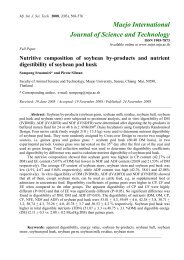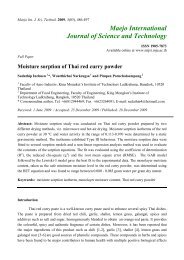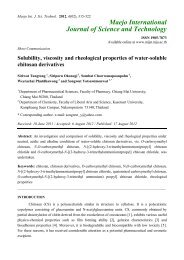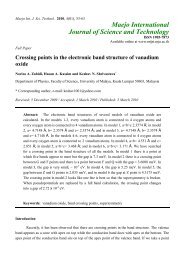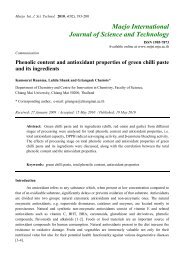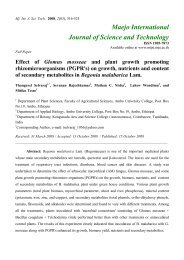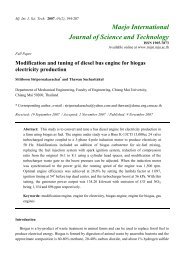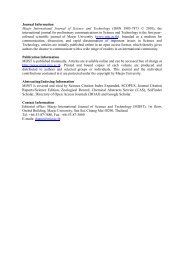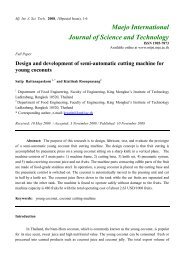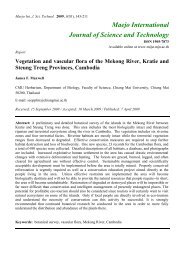Mj. Int. J. Sci. Tech. - Maejo International Journal of Science and ...
Mj. Int. J. Sci. Tech. - Maejo International Journal of Science and ...
Mj. Int. J. Sci. Tech. - Maejo International Journal of Science and ...
- No tags were found...
You also want an ePaper? Increase the reach of your titles
YUMPU automatically turns print PDFs into web optimized ePapers that Google loves.
<strong>Mj</strong>. <strong>Int</strong>. J. <strong>Sci</strong>. <strong>Tech</strong>. 2008, 1(Special Issue), 61-71<strong>Maejo</strong> <strong>Int</strong>ernational<strong>Journal</strong> <strong>of</strong> <strong>Sci</strong>ence <strong>and</strong> <strong>Tech</strong>nologyISSN 1905-7873Available online at www.mijst.mju.ac.thFull PaperAnalysis <strong>of</strong> a continuous fluidised-bed microwave rice kerneldrying systemC. Sangdao 1,* <strong>and</strong> M. Krairiksh 21 Department <strong>of</strong> Telecommunication Engineering, Mahanakorn University <strong>of</strong> <strong>Tech</strong>nology, 51 Moo 1,Cheum-Sampan Rd., Nong Chok, Bangkok 10530, Thail<strong>and</strong>2 Faculty <strong>of</strong> Engineering <strong>and</strong> Research Centre for Communications <strong>and</strong> Information <strong>Tech</strong>nology,King Mongkut’s Institute <strong>of</strong> <strong>Tech</strong>nology Ladkrabang, Bangkok 10520, Thail<strong>and</strong>*Corresponding author, e-mail: chokchai@mut.ac.thReceived: 17 July 2008 / Accepted: 12 December 2008 / Published: 12 December 2008Abstract: This paper presents an analysis <strong>of</strong> a continuous fluidised-bed microwave ricekernel drying system. Its applicator consists <strong>of</strong> perpendicular slots on a concentric cylindricalcavity excited by perpendicular waveguides. Bulk rice to be dried is dropped along thevertical direction into the centre <strong>of</strong> the applicator while ambient air is injected in the oppositedirection. Statistical data <strong>of</strong> electric field <strong>and</strong> temperature distribution in rice kernels werestudied with consideration <strong>of</strong> the probability <strong>of</strong> kernel orientation. It was found that a density<strong>of</strong> kernels at 40 percent <strong>of</strong> the applicator volume with the air flow rate <strong>of</strong> 6 metres persecond was suitable. With a microwave power <strong>of</strong> 3,200W, the heating time was 6 minutes.The expected capacity was 3.93 litres/hour. These results were used for implementing afluidised-bed microwave rice kernel drying system.Keywords: microwave heating, fluidised-bed, rice drying<strong>Int</strong>roductionFluidisation is the process by which solid particles attain a fluid-like state through suspension in aflowing gas or liquid [1]. This state is achieved when the drag force <strong>of</strong> the upward-flowing liquid on theparticles equals or exceeds the weight <strong>of</strong> the particles. Fluidised-bed drying <strong>of</strong>fers the advantages <strong>of</strong>good mixing <strong>and</strong> high heat <strong>and</strong> mass transfer coefficients, resulting in an increased drying rate <strong>and</strong> a
<strong>Mj</strong>. <strong>Int</strong>. J. <strong>Sci</strong>. <strong>Tech</strong>. 2008, 1(Special Issue), 61-7165Table 1. Property <strong>of</strong> rice [17]Property Value Unitk 0.097 (W/mK)tc 1,800mo(kJ/kg C) m 1.347 (g/cc) 4.0 -r310 S/mvertical orientation respectively. These percentages <strong>of</strong> orientation were weighted to calculate theelectric field intensity.A probability density function (PDF) is a function that represents the probability distribution <strong>of</strong> ar<strong>and</strong>om variable. Here, the electric field intensity <strong>and</strong> temperature are r<strong>and</strong>om variables. In this work,the electric field intensity on each rice kernel was sampled <strong>and</strong> plotted as histogram which is afterwardssmoothed out to present the PDF.A cumulative distribution function (CDF) for a r<strong>and</strong>om variable is defined as the probability thatthe r<strong>and</strong>om variable is less than or equal to a specified value. It is the area under the probability densityfunction up to the specified value.Simulation ResultsThe number <strong>of</strong> kernels was varied for density in the applicator to investigate the probabilitydensity function <strong>of</strong> electric field intensity in rice. A personal computer with <strong>Int</strong>el Core 2 CPU 4400 at aspeed <strong>of</strong> 2.0 GHz <strong>and</strong> RAM <strong>of</strong> 2.00 GB was used in the calculation. The CST microwave studio wasutilised in the simulation <strong>of</strong> electric field intensity with a power <strong>of</strong> 1W applied to each magnetron.Consequently, a total power <strong>of</strong> two watts was applied to each applicator. The rice flow rate through theapplicator, ambient air (<strong>of</strong> 30 C flowing in the opposite direction <strong>of</strong> the moving rice), flow rate <strong>and</strong>microwave power were varied.Electric field distributionBy varying the inner radius (from 5.6 cm to 6.6 cm), outer radius (from 7.2 cm to 8.2 cm),cavity length (from 11.0 cm to 12.0 cm) <strong>and</strong> slot length (from 5.6 cm to 6.6 cm), a respective value <strong>of</strong>6.1, 7.7, 11.5 <strong>and</strong> 6.1 cm was suitable for providing a maximum electric field intensity in the cavity. Ittook place near the inner cavity surface at the four positions near the positions <strong>of</strong> the waveguide <strong>and</strong>opposite to the waveguides. Hence, slots were cut at these positions.Kernels were oriented in three directions, viz. radius, circumference <strong>and</strong> vertical, along theapplicator geometry (see Figure 2). As rice density was varied from 20% to 80% <strong>of</strong> the applicatorvolume, the corresponding bulk density varied as shown in Table 2. It was found that the mean value<strong>of</strong> electric field intensity varied corresponding to this density in addition to the orientation. Themaximum values <strong>of</strong> 258 v/m, 118 v/m <strong>and</strong> 82 v/m corresponded to the density <strong>of</strong> 40% oriented in
<strong>Mj</strong>. <strong>Int</strong>. J. <strong>Sci</strong>. <strong>Tech</strong>. 2008, 1(Special Issue), 61-7166radius direction, 80% in vertical direction, <strong>and</strong> 60% in circumference direction respectively.Table 2. Relationship <strong>of</strong> grain <strong>and</strong> bulk densityGrain density (%)1 SeedBulk density (g/cc)2.610 510 0.09620 0.18830 0.28740 0.38350 0.47860 0.57470 0.67080 0.76690 0.861100 0.956Slot 3Slot3Slot 3Slot 2Slot1Slot1Slot 2Slot 2Slot1Slot 4Slot 4Slot 4a) b) c)Figure 2. Electric field distribution in rice kernels :a) Kernels oriented along radius directionb) Kernels oriented along circumference directionc) Kernels oriented along vertical direction(Note: Slots 1 <strong>and</strong> 2 were horizontal slots, while slots 3 <strong>and</strong> 4 were vertical slots.)It is obvious from Figures 2a-c that the electric field distribution has a maximum value at theslot position <strong>and</strong> decreases to a minimum at the centre <strong>of</strong> the applicator. A high value <strong>of</strong> electric fieldintensity could be obtained when the number <strong>of</strong> kernels was less. Most kernels were exposed to anelectric field at a moderate level at all rice densities <strong>and</strong> orientations.Statistical data are illustrated in terms <strong>of</strong> probability density function (PDF) <strong>of</strong> the electric fieldintensity in each kernel (Figure 3). Figures 3a, b <strong>and</strong> c show the PDF when kernels were oriented along
<strong>Mj</strong>. <strong>Int</strong>. J. <strong>Sci</strong>. <strong>Tech</strong>. 2008, 1(Special Issue), 61-7167radius, circumference <strong>and</strong> vertical direction respectively. The highest mean was obtained when ricedensity was 40%, 60% <strong>and</strong> 80% along radius, circumference <strong>and</strong> vertical direction respectively.PDF1.00.90.80.70.60.50.40.30.20.120%40%60%80%100%0 50 100 150 200 250 300 350 400 450E(v/m)PDF1.00.90.80.70.60.50.40.30.20.1a)20%40%60%80%100%0 20 40 60 80 100 120 140 160E(v/m)PDF1.00.90.80.70.60.50.40.30.20.1b)20%40%60%80%100%0 20 40 60 80 100 120 140 160 180E(v/m)200c)Figure 3. Probability density function <strong>of</strong> electric field intensity in rice kernels :a) Kernels oriented along radius directionb) Kernels oriented along circumference directionc) Kernels oriented along vertical directionAt 20% density, the mean electric field intensity was 151 v/m, 35 v/m <strong>and</strong> 75 v/m in the radius,circumference <strong>and</strong> vertical direction respectively. The measured probability <strong>of</strong> orientation in theprevious section was used to weigh the mean electric field intensity in three orientations at densities <strong>of</strong>20%, 40%, 60% <strong>and</strong> 80%. The weighted means at 20%, 40%, 60% <strong>and</strong> 80% densities were 88.0 v/m,133.5 v/m, 88.5 v/m <strong>and</strong> 105.6 v/m respectively. The PDF <strong>of</strong> these cases is illustrated in Figure 4. It isclearly shown that densities <strong>of</strong> 20%, 60% <strong>and</strong> 80% possessed a low mean electric field intensity ranging
<strong>Mj</strong>. <strong>Int</strong>. J. <strong>Sci</strong>. <strong>Tech</strong>. 2008, 1(Special Issue), 61-7168from 1 v/m to 200 v/m. The density <strong>of</strong> 40% had the highest mean value <strong>of</strong> 135 v/m with scattered datafrom 1 v/m to 310 v/m. However, it is not clear which density was suitable.The system was required to provide high electric field intensity, <strong>and</strong> consequently hightemperature, in each kernel. To clarify the reliability <strong>of</strong> the system on how the probability <strong>of</strong> the electricfield intensity was less than the specified value, the cumulative distribution function (CDF) weightedfrom the three orientations at densities <strong>of</strong> 20%, 40%, 60% <strong>and</strong> 80% was plotted as in Figure 5. It isobvious that the density <strong>of</strong> 40% has the least probability <strong>of</strong> the electric field intensity being less than thespecified value. For instance, the probability <strong>of</strong> electric field intensity being less than 150 v/m <strong>of</strong> thedensities <strong>of</strong> 20%, 60% <strong>and</strong> 80% was around 75% while those <strong>of</strong> the 40% counterpart was less than30%. It could be summarised that a rice density <strong>of</strong> 40% was suitable in this application.PDF1.00.90.80.70.60.50.40.30.20.120%40%60%80%0 50 100 150 200 250 300 350 400 450E(v/m)Figure 4. Variation <strong>of</strong> PDF <strong>of</strong> electric field intensity in rice kernel weighted by kernel orientationat various kernel densities1.00CDF0.750.500.2520%40%60%80%0 50 100 150 200 250 300 350 400 450 500 550 600E(v/m)Figure 5. Variation <strong>of</strong> CDF <strong>of</strong> electric field intensity in rice kernel at various kernel densitiesTemperature distributionThe results in the previous section revealed that rice density should be 40% <strong>of</strong> the applicatorvolume. The other parameters included the time the rice was exposed to the electric field <strong>and</strong> the airflow rate. In this section, temperature distribution was calculated at 40% rice density. The airtemperature was set to an ambient temperature <strong>of</strong> 30 C . The practical air flow rate could be variedfrom 0.1 m/s to 6 m/s. Hence, calculation was conducted at 3 m/s <strong>and</strong> 6 m/s. Since a 800W magnetronwould be used in future practice, microwave power for the applicator was fixed at the level <strong>of</strong> 1.6 kW.When two applicators were used, the power was doubled to 3.2 kW. The CDF curves from variouscases are shown in Figure 6, depicting the probability <strong>of</strong> rice temperature being less than the specifiedvalue on the horizontal axis. The curves A, B <strong>and</strong> C are for the cases <strong>of</strong> 1.6 kW microwave power for 2,
<strong>Mj</strong>. <strong>Int</strong>. J. <strong>Sci</strong>. <strong>Tech</strong>. 2008, 1(Special Issue), 61-71696 <strong>and</strong> 10 minutes, while solid line <strong>and</strong> dashed line are for air flow rate <strong>of</strong> 3 m/s <strong>and</strong> 6 m/s respectively. Itwas found that the mean temperatures were 39 C , 58 C <strong>and</strong> 77 C respectively. When two applicatorswere used, a power <strong>of</strong> 3.2 kW was excited. Curves D <strong>and</strong> E show mean temperatures <strong>of</strong> 47 C <strong>and</strong>75 C for the time <strong>of</strong> 2 <strong>and</strong> 6 minutes respectively.When the probability <strong>of</strong> the temperature being less than 50 C was considered by using oneapplicator excited by 1.6 kW microwave power as in curve B, it was found that the probability was 5%.The probability that the temperature was less than 60 C in curve B was 80%, while that in curve C was5%. The probability <strong>of</strong> the temperature being less than 70 C in curve C was 25%, which means that ifthe temperature was over 70 C , the system shown in curve C would provide the best performance.Consequently, when two 800W microwave magnetrons were used, heating time was in excess <strong>of</strong> 10minutes while the air flow rate could either be 3 m/s or 6 m/s. When two applicators that generated 3.2kW were used, the temperature rose to 47 C in 2 minutes, as seen in curve D. As time increased to 6minutes, the temperature rose to 77 C (see curve E). The system in curve E accomplished the bestperformance <strong>of</strong> low probability <strong>of</strong> temperature less than 60 C <strong>and</strong> the least heating time.1.000.75(A)1.6kW.,2Min.(B)1.6kW.,6Min.3m/s6m/s3m/s6m/s(A)(D)(B)(E)(C)CDF0.50(C)1.6kW.,10Min.3m/s6m/s0.25(D)3.2kW.,2Min.(E)3.2kW.,6Min.3m/s6m/s3m/s6m/s0 10 20 30 40 50 60 70 80 90 100Temperature ( C)Figure 6. CDF <strong>of</strong> temperature with microwave power <strong>of</strong> 1.6 kW <strong>and</strong> 3.2 kWat different heating time <strong>and</strong> air flow ratesThe results in Figure 6 demonstrated that by increasing heating time in 4-minute steps, thetemperature could be elevated by 19 Ctemperature rise <strong>of</strong> 30 Cto 20 Cfrom one applicator. The two applicators provided a. A previous work [11] noted that when the temperature was 80 C, heatingtime was in excess <strong>of</strong> 10 minutes in the case <strong>of</strong> one applicator. Two applicators could reduce heatingtime to 6 minutes. The expected capacity was 3.93 litres/hour.ConclusionsThis paper reports on the analysis <strong>of</strong> a continuous fluidised-bed microwave rice kernel dryingsystem. Parametric studies from electric field <strong>and</strong> temperature distribution revealed that suitable ricedensity in the applicator should be 40% <strong>of</strong> the applicator volume. Rice kernels exposed to a 1.6 kWmicrowave power for 10 minutes with the air flow rate <strong>of</strong> 6 m/s had a temperature in excess <strong>of</strong> 77 Cfrom the initial ambient temperature <strong>of</strong> 30 C . This condition was sufficient for reducing moisturecontent in rice. As two applicators were used, microwave power was doubled to 3.2 kW. Thetemperature in the rice was as high as 75 C <strong>and</strong> drying time was reduced to 6 minutes. The expected
<strong>Mj</strong>. <strong>Int</strong>. J. <strong>Sci</strong>. <strong>Tech</strong>. 2008, 1(Special Issue), 61-7170capacity was 3.93 litres/hour. The system drastically increased the capacity as compared to thatpreviously reported. The system will be constructed to validate the simulation results in the future.AcknowledgementsThe authors deeply appreciate anonymous reviewers for their comments that greatly improve themanuscript. This work was supported by the Thail<strong>and</strong> Research Fund (TRF) under contract numberRTA 4880002.References1. J. R. Thomas, Jr. <strong>and</strong> F. Faucher, “Thermal modeling <strong>of</strong> microwave heated packed <strong>and</strong> fluidizedbed catalytic reators”, J. Microwave Power <strong>and</strong> Electromagnetic Energy, 2000, 35, 165-174.2. Y. Tirawanichakul, S. Prachayawarakorn, W. Varanyanond, <strong>and</strong> S. Soponronnarit, “Simulation<strong>and</strong> grain quality for in-store drying <strong>of</strong> paddy”, J. Food Eng., 2004, 64, 405-415.3. A. C. Metaxas, “Foundations <strong>of</strong> Electroheat : A Unified Approach”, John Wiley & Sons,Chichester, 1996.4. M. Zhang, J. Tang, A. S. Mujumbar, <strong>and</strong> S. Wang, “Trends in microwave drying <strong>of</strong> fruits <strong>and</strong>vegetables”, Trends Food <strong>Sci</strong>. <strong>Tech</strong>nol., 2006, 17, 524-534.5. E. I. Goksu, G. Sumnu, <strong>and</strong> A. Esin, “Effect <strong>of</strong> microwave on fluidized bed drying <strong>of</strong> macaronibeads”, J. Food Eng., 2005, 66, 463-468.6. J. Varith, P. Dijkanarukkul, A. Achariyaviriya, <strong>and</strong> S. Achariyaviriya, “Combined microwave-hotair drying <strong>of</strong> peeled longan”, J. Food Eng., 2007, 81, 459-468.7. H. Feng <strong>and</strong> J. Tang, “Microwave finish drying <strong>of</strong> diced apples in a spouted bed”, J. Food <strong>Sci</strong>.,1998, 63, 679-683.8. G. Roussy, S. Jassm, <strong>and</strong> J-M. Thiebaut, “Modeling <strong>of</strong> a fluidized bed irradiated by a single or amultimode electric microwave field distribution”, J. Microwave Power <strong>and</strong> ElectromagneticEnergy, 1995, 30, 178-187.9. W. Radajewski, P. Jolly, <strong>and</strong> G. Y. Abawi, “Grain drying in a continuous flow drier supplementedwith a microwave heating system”, J. Agric. Eng. Res., 1988, 41, 211-225.10. A. P. Mossman, “A review <strong>of</strong> basic concepts in rice drying research”, Crit. Rev. Food <strong>Sci</strong>. Nutr.,1986, 25, 49-70.11. C. Sangdao, A. Roeksabutr, <strong>and</strong> M. Krairiksh, “An applicator for uniform heating usingperpendicular slots on a concentric cylindrical cavity excited by perpendicular waveguides”, <strong>Int</strong>. J.Electron., 2006, 93, 313-334.12. H. Chen, J. Tang, <strong>and</strong> F. Liu, “Coupled simulation <strong>of</strong> an electromagnetic heating process using thefinite difference time domain method”, J. Microwave Power <strong>and</strong> Electromagnetic Energy, 2007,41, 50-68.13. H. Feng, J. Tang, R. P. Cavalieri, <strong>and</strong> O. A. Plumb, “Heat <strong>and</strong> mass transport in microwave drying<strong>of</strong> porous materials in a spouted bed”, Am. Institute Chem. Eng. J., 2001, 47, 1499-1512.
<strong>Mj</strong>. <strong>Int</strong>. J. <strong>Sci</strong>. <strong>Tech</strong>. 2008, 1(Special Issue), 61-717114. V. Vegh <strong>and</strong> I. W. Turner, “A hybrid technique for computing the power distribution generated ina lossy medium during microwave heating”, J. Comput. Appl. Math., 2006, 197, 122-140.15. CST Microwave Studio User Manual, CST GmbH-Computer Simulation <strong>Tech</strong>nology, Darmstadt,2006.16. T. Weil<strong>and</strong>, “A discretization method for the solution <strong>of</strong> Maxwell’s equations for six-componentfields”, Electron. Comm., 1997, 31, 116-120.17. K. P. Thakur, “Modelling the dielectric constant <strong>of</strong> rice grains”, 3rd Workshop onElectromagnetic Wave <strong>Int</strong>eraction with Water <strong>and</strong> Moist Substances, Athens, 1999, pp. 239-245.© 2008 by <strong>Maejo</strong> University, San Sai, Chiang Mai, 50290 Thail<strong>and</strong>. Reproduction is permitted fornoncommercial purposes.




